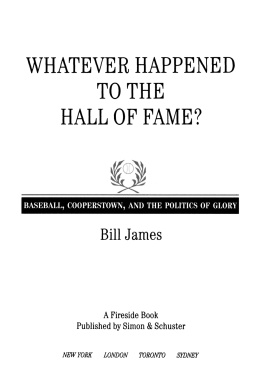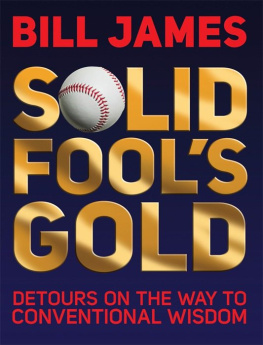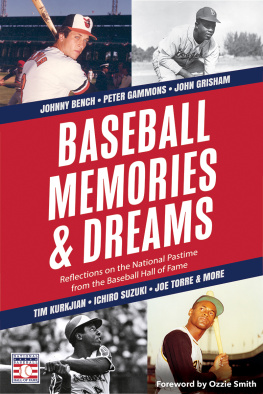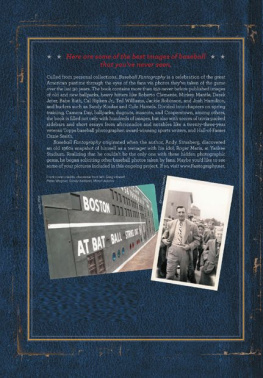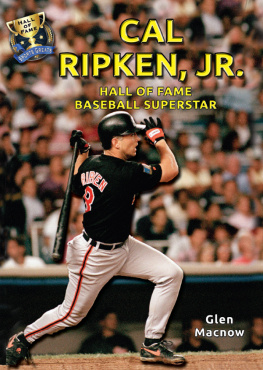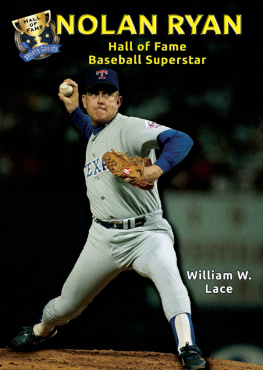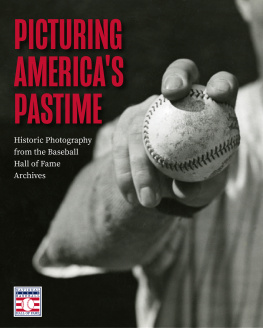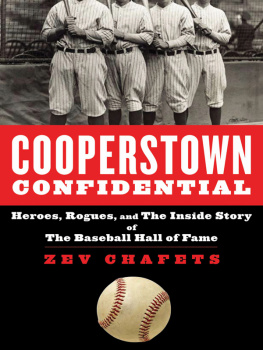Bill James - Whatever Happened to the Hall of Fame
Here you can read online Bill James - Whatever Happened to the Hall of Fame full text of the book (entire story) in english for free. Download pdf and epub, get meaning, cover and reviews about this ebook. year: 1995, publisher: Free Press, genre: Detective and thriller. Description of the work, (preface) as well as reviews are available. Best literature library LitArk.com created for fans of good reading and offers a wide selection of genres:
Romance novel
Science fiction
Adventure
Detective
Science
History
Home and family
Prose
Art
Politics
Computer
Non-fiction
Religion
Business
Children
Humor
Choose a favorite category and find really read worthwhile books. Enjoy immersion in the world of imagination, feel the emotions of the characters or learn something new for yourself, make an fascinating discovery.
- Book:Whatever Happened to the Hall of Fame
- Author:
- Publisher:Free Press
- Genre:
- Year:1995
- Rating:5 / 5
- Favourites:Add to favourites
- Your mark:
- 100
- 1
- 2
- 3
- 4
- 5
Whatever Happened to the Hall of Fame: summary, description and annotation
We offer to read an annotation, description, summary or preface (depends on what the author of the book "Whatever Happened to the Hall of Fame" wrote himself). If you haven't found the necessary information about the book — write in the comments, we will try to find it.
Whatever Happened to the Hall of Fame — read online for free the complete book (whole text) full work
Below is the text of the book, divided by pages. System saving the place of the last page read, allows you to conveniently read the book "Whatever Happened to the Hall of Fame" online for free, without having to search again every time where you left off. Put a bookmark, and you can go to the page where you finished reading at any time.
Font size:
Interval:
Bookmark:

FIRESIDE
Rockefeller Center
1230 Avenue of the Americas
New York, NY 10020
www.SimonandSchuster.com
Copyright 1994, 1995 by Bill James All rights reserved, including the right of reproduction in whole or in part in any form.
First Fireside Edition 1995
F IRESIDE and colophon are registered trademarks of Simon & Schuster Inc.
Designed by Michael Mendelsohn of MM Design 2000, Inc.
Library of Congress Cataloging-in-Publication Data James, Bill.
Whatever happened to the Hall of Fame? : baseball, Cooperstown, and the politics of glory / Bill James. - 1st Fireside ed.
p. cm.
Originally published: The politics of glory. New York : Macmillan, c1994.
A Fireside book.
Includes index.
1. National Baseball Hall of Fame and Museum. I. James, Bill. Politics of glory. II. Title.
[GV863.A1J375 1995]
796.3570973-dc20
94-44926 CIP
ISBN-13: 978-0-684-80088-2
ISBN-10: 0-684-80088-8
ISBN: 978-1-43910-837-6 (eBook)
Previously titled The Politics of Glory
This book is for Rachel McCarthy James, who is a big girl now and can read books with no pictures
CONTENTS
ACKNOWLEDGMENTS

The people who helped me put this book together could be sorted into three groups, probably. I dont know what the three groups are or why I would want to sort them, but since everything else in the damn book is sorted into groups A, B, and C, I thought this would be an appropriate place to start. Im sure I could figure out the three groups if I had to.
Rob Neyer worked with me for four years, during which time we often talked about this book, and did some actual work on it. He has moved on to bigger and better things, and John Sickels now works as my research assistant. Both of them put many hours into this book, and contributed to it their intelligence and insights.
A number of people who work at the Hall of Fame or have worked at the Hall of Fame shared with me their experiences. Tom Heitz, Librarian at the Hall of Fame, was very generous with his time and his files, which were of inestimable value to me. Bill Deane, who works with Tom, was equally accommodating, as was Cliff Kachline, who worked at the Hall of Fame for many years, and who still lives in the Cooperstown area. All three men have gracious and beautiful wives, Ginger Heitz, Pam Deane and Evelyn Kachline, who also were kind to me in my time south of Utica and north of the Catskills.
Bill Rosen and Gillian Sowell, of Macmillan Publishing, accepted without complaint the thankless responsibility of trying to get work out of me.
My wife, Susan McCarthy, was supportive as always. Since this book was sent on its way my two wonderful children have become three-Rachel, now eight years old, Isaac, soon six years old, and Reuben, who is brand new. Daddy, did you finish your book yet? is still a daily question in my household, and for every day that the answer was No, one thank you is now in order.
I am personally responsible for all errors, misstatements, inaccuracies, omissions, commissions, comminglings, communisms, fallacies... if its wrong and its in this book, its my fault. My thanks also to John Dewan, Bill Guilfoile, Liz Darhansoff, Lloyd Johnson, Phil Rizzu-to, Jim Carothers and Pete Palmer. Its a short list, but a serious one.
B ILL J AMES


HUNDREDS OF VISITORS A YEAR

Grand Victorian mansions were slipping into disrepair. What to do? A coat of paint herethat could waitbut if the roof leaks? If the foundation cracks? Those things could not wait for better days, any more than a hungry child could wait until the Depression was over to ask for food. The ballroom floor contemplated a future as firewood; the grand oak stairway looked into salvage. Whatever shall we do?
The gray-green fingers of a dead economy held not merely the town, nor the region, nor the state, nor even the nation. This was not your fine 1990s Depression we speak of here, beggars pestering the matrons on their way to lunch; this was The Depression.
On the weekend of May 5-7, 1934, Alexander Cleland, an employee of Cooperstowns wealthiest patron, had an ideaan idea, in retrospect, that seems implausibly humble. He didnt know a damn thing about baseball, but he knew that people were nuts about it. He knew that the village of Cooperstown, New York, held some vague claim to being the birthplace of baseball. His idea was that Cooperstown, under the direction of the Clark Foundation, could assemble a collection of baseball artifacts which might draw hundreds of people a year to the village to see them.
He wrote that in his proposal: hundreds of visitors a year.
Cooperstown, by the mid-thirties, had been a resort area for a century or more. Wealthy New Yorkers from time out of memory had escaped the summer by vacationing around Otsego Lake, and had left the area dotted with magnificent houses too big to be quite practical.
One of the wealthy families that flocked to the lake and built a grand house there was the family of Ambrose Jordan, a successful New York attorney. Jordans daughter married Edward S. Clark, who was to become the business brains of the Singer Sewing Machine Company.
The story of the Singer Company, though it bears only tangentially upon the Hall of Fame, is too good to pass up. The Singer sewing machine was invented by a man named Isaac Singer, like the writer Isaac Bashevis Singer, two famous guys in the whole world named Singer and their mommies have to name them both Isaac, go figure. Isaac Merritt Singer was born penniless in 1811, the eighth child of an immigrant millwright. Like Mozart and John Riggins, like Danton and Babe Ruth, he was lazy, arrogant, vain, vulgar, brilliant and compulsive; if not actually lazy, at least so undisciplined as to be often accused of laziness; if not actually arrogant, so stubborn as to seem arrogant. Singer could read and write at a third-grade level, but one way or another he memorized large portions of Shakespeare and became an actor. Disdaining any real work, he traveled around the country with small troupes of thespians, concentrating most of his energy on seducing the local maidens.
Occasionally he would invent something, but in his early years he would just sell off the rights and squander the money on women and wine. In the late 1840s he built a better sewing machine. Elegant in its simplicity, Singers machine, like Bill Mazeroski on the double play, accomplished its purpose with so little wasted motion that all previous sewing machines seemed vaguely spastic.
By this time Singer was trying to support a wife, two mistresses and eight children. He needed money. He knew he was on to something this time, so he held on to the rights, which inevitably locked him in a lawsuit over the patent. He attempted to retain a New York attorney, Ambrose Jordan, to handle his case, but Jordan didnt want to have anything more than necessary to do with the man, and referred him to his junior associate/son-in-law, Edward Clark.
This was a moral dilemma for Clark, for on the one hand he knew that Singer could hold the key to a fortune, and on the other hand it meant becoming partners with a man who had one foot in purgatory. Turning a deaf ear to his wifes protestations, the straitlaced Clark decided that the opportunity was too good to pass up. He became the business head of the Singer Sewing Machine Company.
Next pageFont size:
Interval:
Bookmark:
Similar books «Whatever Happened to the Hall of Fame»
Look at similar books to Whatever Happened to the Hall of Fame. We have selected literature similar in name and meaning in the hope of providing readers with more options to find new, interesting, not yet read works.
Discussion, reviews of the book Whatever Happened to the Hall of Fame and just readers' own opinions. Leave your comments, write what you think about the work, its meaning or the main characters. Specify what exactly you liked and what you didn't like, and why you think so.

